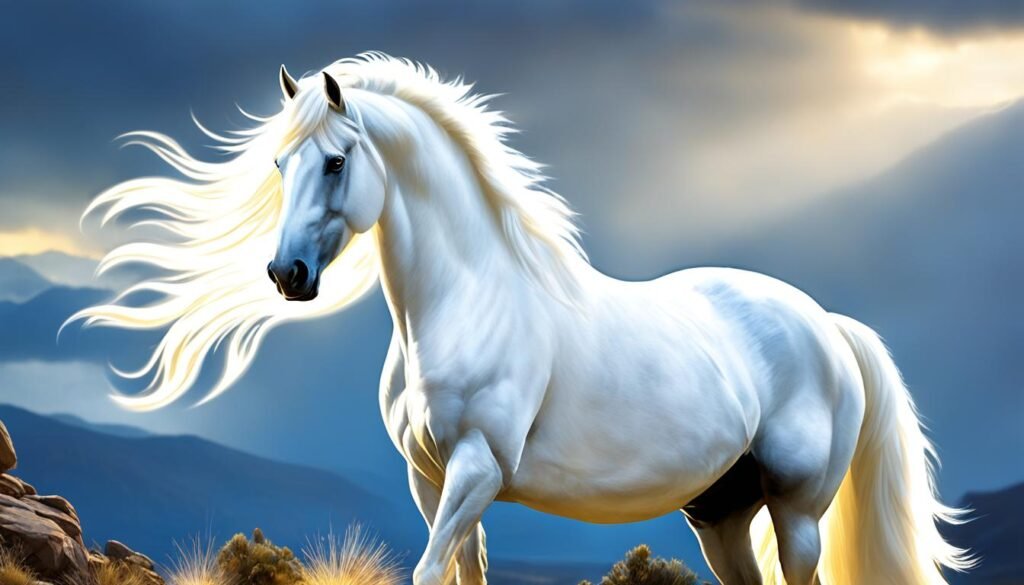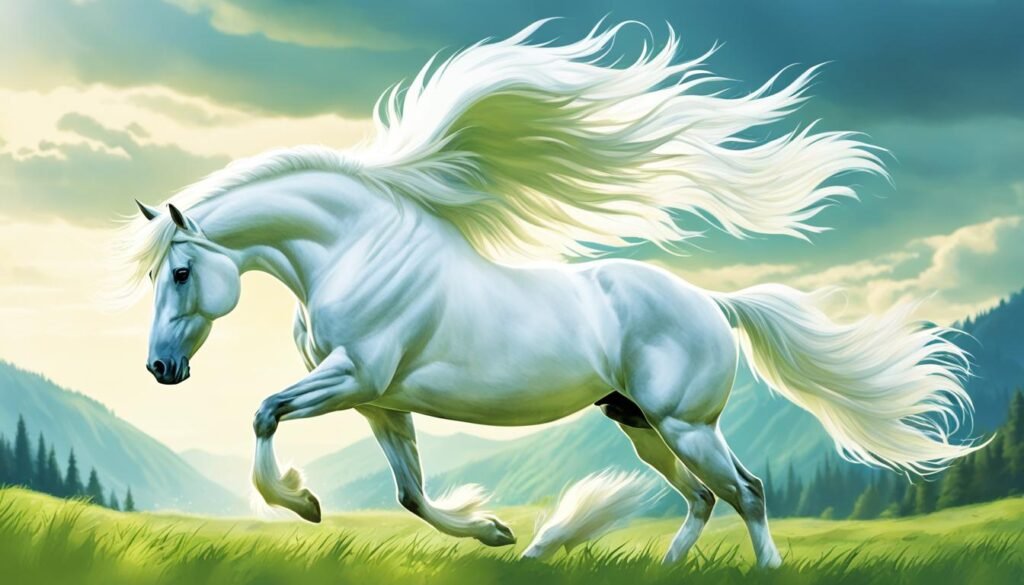In the lush, green Philippines, a fascinating tale is told. It captures the imagination of everyone who listens. The story is about the White Stallion of Pangantucan. It’s a legend filled with wisdom and salvation. These themes are found deep in the culture of the area.
For ages, white horses have been important in myths around the globe. They’re often seen as the mounts of gods or special beings. Stories from the Buddha’s white horse Kanthaka to the Odin’s eight-legged steed Sleipnir show them as divine. Even in the Bible, Conquest rides a white horse. Christ rides a white horse for his second coming as well. Dreams about white horses can mean confidence, enlightenment, or the power to beat challenges.
Key Takeaways
- The White Stallion of Pangantucan is a legendary tale rooted in the rich culture of the Philippines.
- White horses hold significant mythological significance across various belief systems and cultures.
- The white horse is often associated with deities, holy figures, and divine beings, representing attributes like purity, enlightenment, and wisdom.
- In the Bible, the white horse is connected to the concept of conquest and the second coming of Christ.
- Dreams of white horses often symbolize confidence, luck, and the ability to overcome troubles.
Introduction to the Legend
The White Stallion of Pangantucan legend is fascinating. It’s been shared over many years in the Philippines. The story is from Pangantucan, a place that’s filled with culture and spirituality.
This mythical horse is known for its bright white fur and magical presence. It symbolizes wisdom and a connection between our world and the spiritual one. The story encourages us to search within ourselves for true understanding. It blurs the line between what we see and what is sacred.
| Key Elements of the Legend | Significance |
|---|---|
| The White Stallion | A majestic and mysterious creature, embodying the qualities of wisdom, strength, and enlightenment |
| Pangantucan | The region in the Philippines where the legend is deeply rooted, reflecting the cultural and spiritual heritage of the local people |
| Spiritual Journey | Individuals or communities seeking guidance and wisdom from the White Stallion, facing challenges and learning valuable lessons along the way |
Exploring this story lets us look into Philippine mythology. We get to see what the white horse stands for. And we find out why this tale is still loved today.
Mythological Significance of White Horses
White horses mean a lot in many cultures. They’re seen as signs of gods, holy figures, or divine beings. The white horse is all about purity, wisdom, and spiritual light.
Symbolism of White Horses in Various Cultures
In Hindu mythology, there’s Hayagreeva, Vishnu’s avatar with a horse head. He stands for knowledge and wisdom. In the Bible, the white horse symbolizes Jesus’s return and victory. Its deep meanings symbolize powerful spiritual themes.
Representation of Enlightenment and Purity
White horses are symbols of enlightenment and purity in cultures worldwide. The Slavic god Svantovit used a white horse for prophecy. Even Siddhartha (later Buddha) had a sacred white horse named Kanthaka. The white horse’s spiritual role is found everywhere, beyond borders and backgrounds.

The Origin of the Legend
The story of the White Stallion of Pangantucan comes from the Pangantucan region in the Philippines. This area, part of Bukidnon province, is rich in history and nature. The legend tells of a mystical horse. It has been shared for years, showing the culture and beliefs of the local people. Knowing about Pangantucan helps us see the meaning and start of this story.
Pangantucan: A Glimpse into the Region
Pangantucan is a place in the Philippines, covering 46,172 hectares. It stands out as the 9th largest in Bukidnon. Most of its land is rolling or hilly, making only a little bit good for farming. Mount Kalatungan, reaching 2,824 meters high, takes up a big part of the area. The climate here is known for a lot of rain, with an average rainfall of 2,764.60 millimeters. June sees the most rain, while February is the driest month.
The Legendary White Stallion
At the legend’s core lies the white stallion, a stunning and mystical being. It’s known for its beautiful white fur shining with divine purity. This mighty horse is renowned for its wisdom, strength, and enlightenment.
Physical Characteristics and Mystical Aura
The white stallion symbolizes divine direction and spiritual salvation. It embodies the dreams and faith of the people in a way that captivates everyone. Just being near it brings a sense of spiritual awe.
Embodiment of Wisdom and Salvation
The white stallion is a muse of divine insight and a bringer of salvation. Its very being is thought to guide and enlighten any who wish to understand the mysteries of life. It encourages people to move past the limits of this world.

The Journey of Enlightenment
The tale of the White Stallion of Pangantucan tells a story of enlightenment. It shows how people or groups seek wisdom from it. This journey is filled with tests and obstacles.
Seekers must push through personal and outside challenges to gain deep insights. They aim to have life-changing experiences offered by the White Stallion.
Challenges and Obstacles Faced
The path to enlightenment tests those who walk it. Challenges like doubts, fears, and outside pressures loom large. It’s crucial to know oneself deeply and tackle personal limits.
For those striving to find the White Stallion, dedication is key. It means confronting fears and sticking to the path of spiritual growth despite hardships.
Lessons Learned Along the Way
Meeting the White Stallion teaches important life lessons. These include understanding oneself and the value of spiritual commitment. Seekers also learn about how everything is connected.
The White Stallion’s wisdom helps them see the world differently. It gives them the insight to live more clearly and purposefully.
Pangantucan
Pangantucan stands at the center of a famous legend. It’s a place in the Bukidnon province, in the Philippines’ south. This area is loved for its many sights, from dense forests to gentle hills and good farmlands. The folks here celebrate a rich culture, born from nature and history. The story of the White Stallion is key to their beliefs, showing their respect for the land and all life.
This municipality covers about 46,172 hectares, making it the 9th biggest in Bukidnon. It includes 19 villages and had 56,580 people living in it as of the last count. Most parts are hilly, leaving only 14% for farming. Mount Kalatungan, a tall peak at 2,824 meters, takes up a big piece of the town.
During 1995 to 2000, rain here was plentiful, with 2,764.60 millimeters yearly. Despite being rich in farms, about 31.70% of people lived in poverty by 2020, which improved over time. The town keeps growing, with more men than women living here.
Farming is vital in Pangantucan, using 17,429 hectares of land. They grow crops like corn, rice, bananas, pineapples, and papayas. Raising animals is also big, with over 20,000 livestock and nearly 57,000 chickens in 2002. The town supports farming with tractors and other tools. Plus, it has about 232 shops to help the economy.

The Legacy of the White Stallion
The tale of the White Stallion of Pangantucan has been passed down for ages. It leaves a strong mark on the culture and spirituality of the area. This mythical creature is valued as a figure of great wisdom, insight, and the link between the real and mystical worlds. It continues to inspire and lead the locals on their spiritual paths.
Cultural and Spiritual Significance
The story’s importance stretches across many areas of Pangantucan’s life. It influences everything from religious practices to how they care for their natural environment. Such traditions are tightly woven into the town’s identity. They join the people in their past and their beliefs in a higher power.
This shows clearly during the region’s cultural and spiritual events. At these times, the White Stallion is especially honored. Its story also lives on in local creative works and writings. Through these ways, the White Stallion’s story deeply affects the locals and their shared thoughts.
A special bond with the surroundings, known as the White Stallion’s realm, encourages the care of nature. This love for the land and belief in its sacredness leads to actions to safeguard the area’s plants and wildlife. Thus, the legacy of the White Stallion is not just a story, but an ongoing commitment to preserving their environment.
Interpretation and Relevance Today
The story of the White Stallion of Pangantucan remains significant today. It touches people from all walks of life. As we face tough challenges in society, nature, and spiritually, the timeless teachings and wisdom from the horse’s tale are getting a new look. They’re used to tackle modern issues.
Adapting the Legend’s Teachings
Leaders, scholars, and spiritual guides are working hard to keep the legend alive. They see its power to help people grow, take care of nature, and understand humanity better. By updating the legend’s message for our time, they make sure the White Stallion’s wisdom stays valuable.
Preserving Cultural Heritage
Keeping the cultural treasure of the White Stallion is vital for Pangantucan and its people. They share the story, teach it, and protect the lands tied to it. This way, the legend keeps inspiring and guiding the young. Preserving the cultural heritage lets Pangantucan protect its unique history and help everyone understand the diverse human story.
Symbolism in Art and Literature
The story of the White Stallion of Pangantucan inspires many. It appears in both written works and art. Authors and artists use the mythical horse to explore deep themes like spirituality and change. They also look at how it affects humanity.
Artists beautifully depict the White Stallion, showing its power and spiritual meanings. These artworks help keep the legend alive. They also teach new people about its messages. This legend touches hearts and minds across cultures and times.
Artistic Representations of the Legend
The artistic representations of the legend come in many types, from detailed paintings to moving poems. These works don’t just show how beautiful and special the amazing horse is. They also explain its spiritual importance to the people of Pangantucan.
Through art, the legend of the White Stallion lives on. It shares its wisdom and connection beyond any one time or place.
Related Legends and Folklore
The story of the White Stallion of Pangantucan connects with many myths worldwide. In different cultures, the white horse symbolizes divine help, wisdom, and moving beyond the earthly. This makes it a common symbol in various belief systems.
Similarities and Differences
Though told differently, similar legends and folklore point to our shared wish for spiritual wisdom and truth. Comparing the White Stallion myth with others helps us see the common myths in different cultures.
In the Philippine myths, a white horse is a well-known symbol. One example is Bakunawa, who changes from a sea goddess to a serpent god. This monster mirrors the White Stallion’s mix of the real world and spiritual world.
| Mythological Creature | Description | Similarities to White Stallion | Differences from White Stallion |
|---|---|---|---|
| Bakunawa | A dragon-like serpent with a transformative story from a sea goddess to a serpent deity | Both represent the blending of the physical and metaphysical realms | The Bakunawa is a serpentine creature, while the White Stallion is a horse |
| Kapre | A tall, terrifying, and hairy tree giant, ranging from 7 to 9 feet in height | Both are associated with the natural world and the supernatural | The Kapre is a humanoid creature, while the White Stallion is an equine |
| Aswang | A mythological creature in the Philippines that is a type of vampire or witch | Both are deeply rooted in the cultural and spiritual beliefs of the Philippines | The Aswang is a malevolent creature, while the White Stallion is associated with wisdom and salvation |
Comparing the White Stallion story with similar legends leads to a better grasp of universal spiritual themes. These stories also show the specific cultural aspects that influence Filipino spiritual views.
The Enduring Appeal of the Legend
The tale of the White Stallion of Pangantucan never fails to mesmerize. It connects with people from all walks of life. It raises deep questions about life, wisdom, and the divine. The White Stallion symbolizes enlightenment, purity, and the interconnectedness of all things. This touches our hearts and minds, encouraging us to find ourselves and grow spiritually.
The story’s lasting charm proves the might of old tales. It also shows our persistent longing for the holy and mysterious. In our complex world, these ancient teachings offer valuable lessons. They remind us of the power of myths even today.
| Factors Contributing to the Enduring Appeal | Impact on Audiences |
|---|---|
| Symbolic Representation of Enlightenment and Purity | Inspires Spiritual Introspection and Self-Discovery |
| Timeless Themes of Purpose, Wisdom, and the Divine | Resonates with Audiences Across Generations and Cultures |
| Power of Storytelling and Connection to the Mystical | Fulfills the Enduring Human Need for Spiritual Meaning |
The White Stallion of Pangantucan’s story is truly timeless. It inspires us to reflect on life’s deepest mysteries. This is how it captures the hearts and minds of those who hear it.

Conclusion
The story of the White Stallion of Pangantucan is rich and captivating. It comes from the Philippines’ deep cultural and spiritual roots. This mythical horse is known for its unique looks and deep meanings.
People from all over the world are drawn to this legend. It speaks to our shared wishes for wisdom and spiritual connection. Even today, its story guides us through life’s challenges.
The White Stallion’s tale shows the strength of the human spirit. It also proves the lasting impact of sacred stories. Its message continues to touch hearts and minds, encouraging personal and spiritual journeys.

